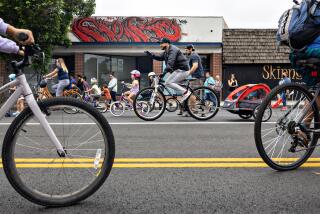Op-Ed: Legalize L.A. street vendors
For decades, sidewalk vendors have brought commerce, food and culture to neglected public spaces in Los Angeles. An estimated 10,000 of them roam the city’s streets, bringing fresh fruit to neighborhoods with few supermarkets, perfuming street corners with the smell of frying onions and delighting children with paletas and other frozen treats.
But under current city laws, every sale they make is illegal.
L.A. is a hotbed of interesting street food, but it is also the only one of the nation’s 10 largest cities to completely outlaw sidewalk vending. At a time when the city is finally trying to develop a more vibrant urban core and make its streets more friendly to pedestrians and cyclists, the ban needs to be lifted.
It’s time to create a citywide permit system to allow vendors to sell on sidewalks and in parks, with rules to allow pedestrian passage, to encourage safe and nutritious food and to collect sales taxes to help city finances. The city has considered enacting such a law a number of times but has not done so. And currently, the City Council is considering cracking down harder on vendors in public parks.
Street vending used to be legal in Los Angeles. A hundred years ago, when the streets were more vibrant, with trolleys, pedestrians, horse carts and cars all coexisting, a vendor could pay a fee to be licensed as a foot peddler, a peddler with a horse and wagon, or a seller of merchandise from a stand on the sidewalk.
Restrictions on vending increased at about the time the car began to gain supremacy in Los Angeles life. In the mid-1930s, the city banned vending on sidewalks downtown, and then in other major business districts.
In 1974, the City Council voted to ban sidewalk vending throughout the city. Mayor Tom Bradley vetoed the ordinance because he felt it would harm the poor. As he put it, “I believe we need to encourage, not discourage, the creation of new small-business enterprises, without which upward mobility on the socioeconomic ladder would become that much more difficult.”
Bradley’s veto was only a temporary setback for the anti-vendor sentiment, however, and in 1980, the city finally banned all sidewalk vending — or at least it tried to. Selling on the street, it turned out, couldn’t be so easily contained. One factor in street vending’s persistence was increased immigration from countries where people expected to be able to sell and buy street food. Another was the economic downturn of the early ‘90s, during which many people turned to vending to survive.
In 1994, acknowledging this reality, the City Council voted to legalize sidewalk vending in designated districts around the city. But the process it set up to establish the districts was so complex that it took five years to get the first (and only) one, in MacArthur Park, started. Because of red tape and lack of enforcement outside of the district, it shut down several years later.
The present lack of a permit system criminalizes vendors who just want to make a living. It deprives the city of tax revenue and licensing fees. And it potentially puts the public at risk, because vendors selling food on the black market have little incentive to familiarize themselves with and adhere to health codes.
Los Angeles has tried banning vending. It has tried ignoring the issue. It has tried limiting vending to small vending districts. None of these approaches has worked. We need a citywide permit system for selling on sidewalks and in parks, and it needs to have sensible rules and incentives to encourage more vending of nutritious food. The motions being considered by the City Council are an opportunity to bring vendors out of the shadows and to legalize a more walkable, prosperous and delicious city.
Mark Vallianatos teaches at Occidental College and serves on the steering committee of the Los Angeles Street Vendor Campaign. He wrote chapters on vending in Los Angeles in two recent books: “The Informal American City” and “Incomplete Streets.”
Follow the Opinion section on Twitter @latimesopinion
More to Read
A cure for the common opinion
Get thought-provoking perspectives with our weekly newsletter.
You may occasionally receive promotional content from the Los Angeles Times.






